
An indigenous maize variety is making a strong comeback in parts of Homa Bay County with local farmers hailing its resilience, taste and fast maturity rate.
Walter Opiyo, a subsistence farmer in Gem East Location in Rangwe Sub-county, is among farmers that have reintroduced this traditional maize variety into local farms.
Speaking to journalists, Opiyo said he first encountered the variety in the last planting season and was impressed with its performance.
“I planted it and it did so well. It is resistant to pests and diseases just like cassava. Its maturity period is just two and a half months, which is shorter than the commonly available hybrid varieties,” Opiyo said.
Opiyo praised the maize variety for its distinct qualities, noting its superior taste whether roasted or milled into maize flour.
“It has a colour that is neither white nor too dark when ground and makes a sweet and nutritious maize meal,” he said.
The small-scale farmer says he initially planted just two kilogrammes of seeds, which he had bought at a high price. Despite this, the harvest was good and he later sold some of the produce to other farmers in the area, sparking renewed interest in the variety as many of them are now growing the variety.
“This is the second season I am planting it. Last season, the yield was high. Despite the recent heavy rains this season, the crops were a bit affected but maize is doing well,” he said.
Opiyo called on the department of agriculture to support farmers in accessing the indigenous seeds, which he said are often expensive and hard to find.
“I bought the seeds at a high price. If the government can step in and make this variety of maize easily accessible and more affordable, it will be beneficial for farmers and more will embrace it,” he urged.
According to Opiyo, the maize’s resistance to common pests and diseases makes it a cost-effective choice for farmers, noting: “You do not need fertiliser or pesticides. It grows well on its own and still produces good yields.”
His wife, Priscilla Mueni, initially doubted the maize’s potential due to its unusual colour but later changed her mind after tasting the boiled maize and seeing the harvest.
“I did not like it at first, but after harvesting and cooking it, I saw the difference. It is delicious and very productive,” said Mueni.
She added that her children have since developed a preference for meals made from the indigenous maize, particularly when roasted or made into a maize meal. The couple now relies exclusively on this maize for their household consumption and believe more awareness should be raised about its benefits.
“People reject it because of its colour, but they do not know they are missing out on a nutritious and profitable crop, it is akin to gold,” Mueni said. “With proper sensitisation, farmers can grow it not only for food but for sale.”
The Opiyos, who also grow cassava, simsim and other crops in their farm are now advocating for more education campaign to promote the indigenous varieties among other farmers and opening up of market opportunities for those who grow it commercially.
- A Tell Media / KNA report / By Sitna Omar







